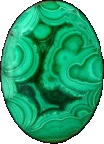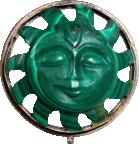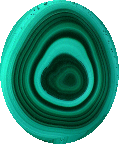| |
Malachite
|
Malachite comes from the Greek molochitis meaning "green mallow stone." Care should be taken when reading the old lapidaries because the term is also applied to green jaspers and opaque emeralds.
Though quite beautiful, this gem is actually copper ore. Humans have been mining the stone since at least 4000 B.C., yet its folklore is strangely specific and appears to be cognitively mapped to an unknown system of belief or folkloric taxonomy. The folklore of most gemstones is usually derived from a cultural interpretation of the physical appearance of the stone, or the tendency of medieval scholars to map everything to astrological correspondences. Neither of these situations would explain the solar associations of the malachite, suggesting that the earliest folklore is based on a much earlier, quite literally prehistoric, cultural interpretation.
It is unusual for such folklore to be transferred to later cultures relatively intact. However, the utilitarian need for the metal may explain how such an easily workable and aesthetically pleasing stone has such a unique folkloric profile. The copper extracted from malachite was historically much more valuable and fundamentally necessary than the stone’s use as a decorative material. It is very likely that, like hematite, the majority of the mined malachite was destroyed in the smelter while extracting the copper.
It is possible that this connection with fire and heat, and the metal extracted from the malachite, also explains the strange folklore associated with it. In all of the earliest accounts this stone represented the sun and the protective power of the day over revenants, phantoms, night terrors, and other assorted nocturnal evils. The connection of the malachite to the sun is so entrenched in folk belief that multiple lapidaries tell of an amulet that can be created by engraving a sun on a malachite and setting it in silver. This amulet would protect the wearer from witchcraft, evil spirits, and venomous beasts. Though repeated in several lapidaries, I know of no historical examples of such an amulet.
The belief that malachite will protect children if hung from a crib or bed is also related to the stone’s association with the sun and the ability of the daylight to drive away night terrors and other nocturnal denizens that would seek to harm or frighten the child.
The malachite was imbued with a wider range of related powers as the need for copper waned. Lapidaries in Italy and parts of southern Europe would isolate single nodules out of chunks of malachite, then slab it horizontally. When these slabs were cut en cabochon they created a bullseye pattern in the polished gem. Individuals in those regions still treasure pendants made from these specially cut stones as amulets that warded off misfortune and the evil eye.
The decreased value of copper during the iron age very likely made the ore more valuable for its decretive properties than its metal content. This would have increased the population’s exposure to the material as a precious stone, and shifted its position in the cognitive map of the culture. Medieval doctors soon began using powdered malachite in medicines for heart conditions. This was a very dangerous practice as ingesting malachite powder could lead to copper poisoning. This period also saw an expansion of the malachite’s folkloric properties, imbuing it with the power to improve weak constitutions and protect from muscle strain and hernias. This divorce from its earlier solar associations suggests that the cultural constructs that linked the malachite to the sun were no longer present in Medieval Europe.
Today many consider malachite the "Merchant’s Stone", and bestow upon it the ability to improve financial endeavors. This may come from malachite’s use as an indicator material for more precious metal ores, or perhaps because the stone is green like modern money. In any case it is said to be beneficial if kept with coins or money, or if worn by individuals such as shopkeepers and servers while doing monetary transactions.
|
Colors
|
Banded shades of green
|
Locations
|
Africa, France, South Australia, Namibia and USA
|
Compisition
|
Cu2,CO3,(OH)2, copper ore derivative
|
Hardness
|
6 - 7
|
|

|

|

|
|
|
|
|
|